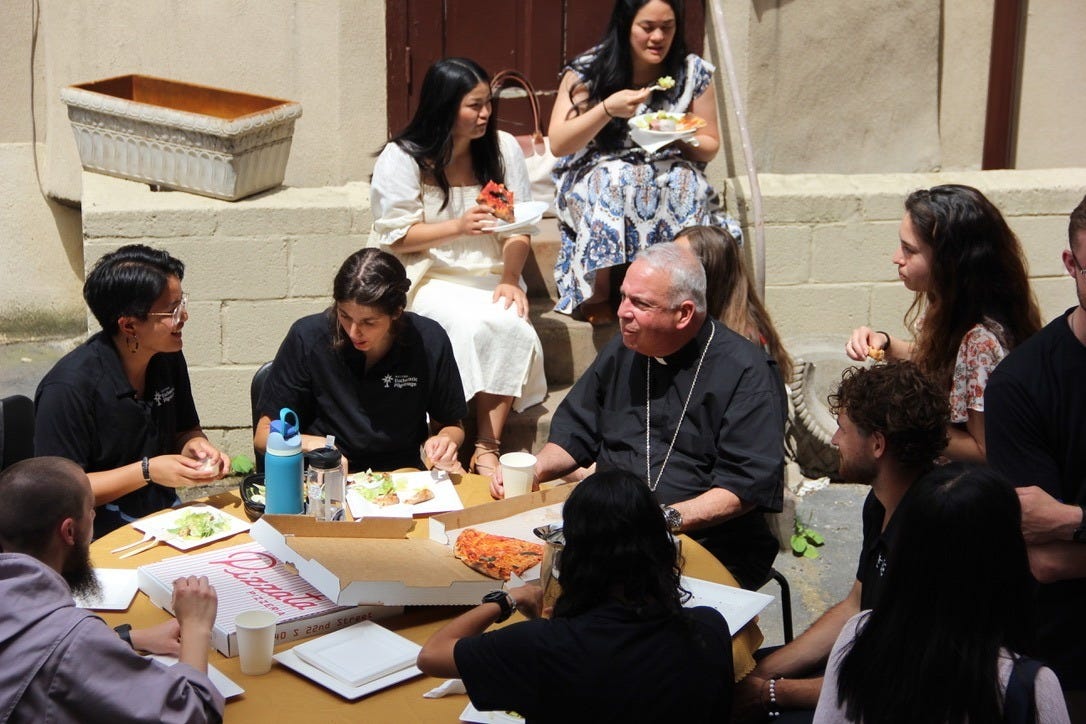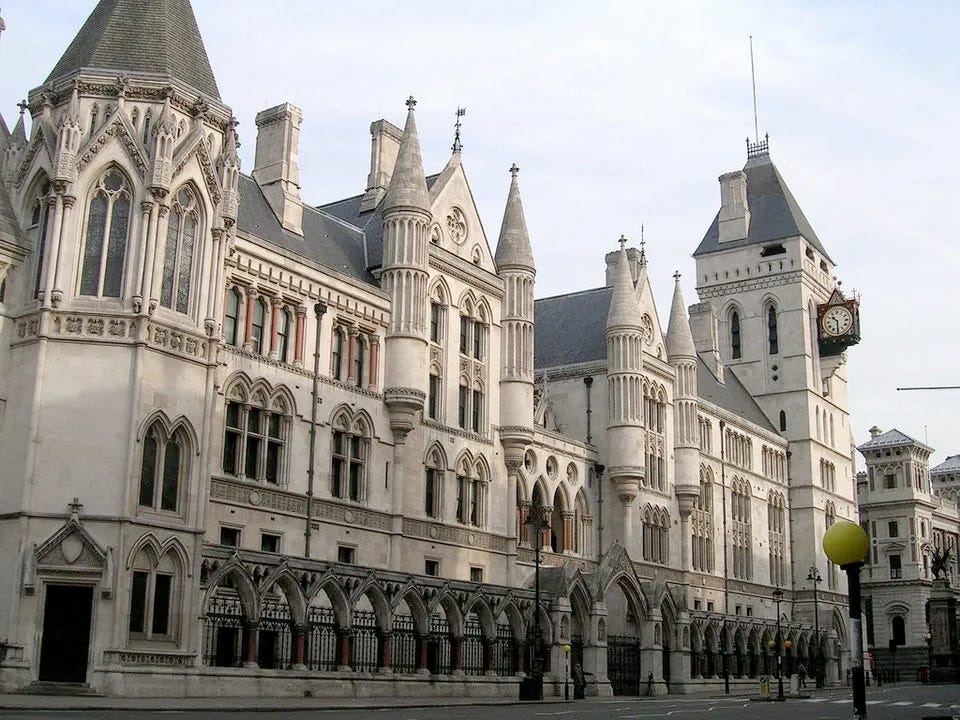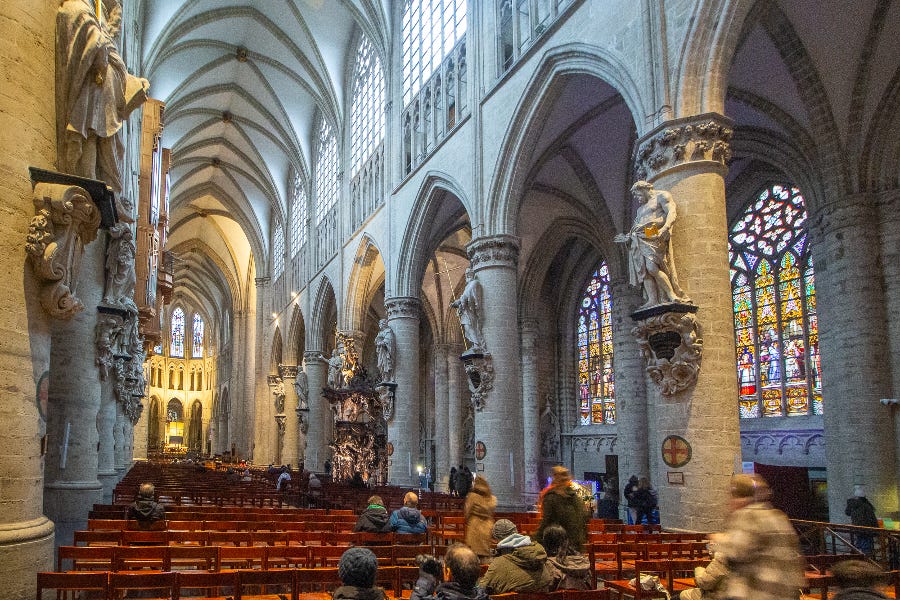There are only three constants on the National Eucharistic Pilgrimage: the Blessed Sacrament, the six perpetual pilgrims, and a lack of sleep.
Everything else changes, all the time.
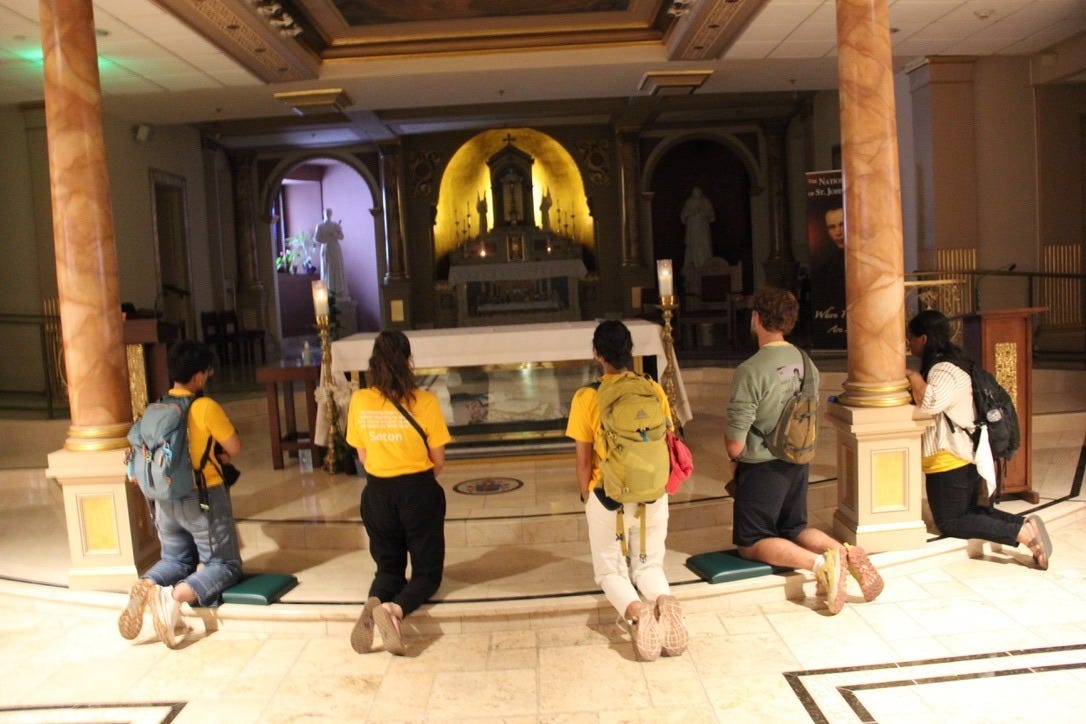
On the Seton Route of the National Eucharistic Pilgrimage, which is traveling now across the northeast, pilgrims say the long days on the road, sleepless nights, and constant conversations are worth the burden, because they have a pretty great summer job—traveling across the country with the Lord.
“We are living out discipleship in a whole new way,” Seton route team lead Natalie Garza told The Pillar recently.
“We are actually getting to know Jesus in the scriptures in a whole different way, and the scriptures seem like a mirror to my life as we walk across the northeast with Jesus.”
Natalie is joined by five other “perpetual pilgrims” on the Seton Route of the National Eucharistic Pilgrimage. Their trip began in New Haven, Connecticut, on May 19 and will conclude on July 17 in Indianapolis, Indiana, for the National Eucharistic Congress.
The Seton Route is one of the four National Eucharistic Pilgrimage routes, by which young adults are walking with the Blessed Sacrament across the country as part of the USCCB’s three-year National Eucharistic Revival.
The pilgrims come from diverse backgrounds. Garza is a theology teacher at St. James Academy in Kansas City. She is joined by Marina Frattaroli, who just graduated from Columbia Law School in May. Amayrani Higueldo, a first-generation college graduate, just became a nurse.
Zoe Dongas quit her job working for the Archdiocese of New York to serve as a perpetual pilgrim. Christoph Bernas is a second-year seminarian for the Diocese of Pittsburgh, and Dominic Carstens just graduated from Wyoming Catholic College.
The journey to Indianapolis for those six means a lot of walking, sleeping in a different bed every night, and a whole lot of liturgy. But the pilgrims say they’re making great memories.
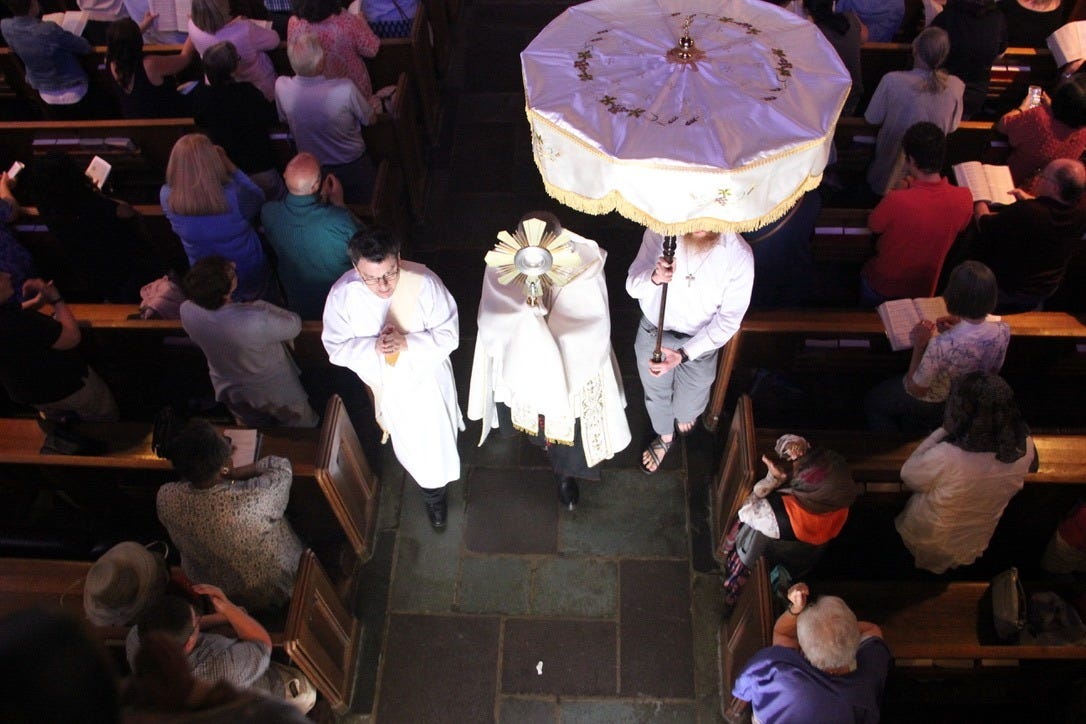
“I will remember this as the greatest adventure,” Frattaroli told The Pillar. “I saw more than I ever had seen before, and I've traveled a lot; I've met more people and a more diverse array of people than ever before. I've seen deeper into Jesus's own heart than before.”
“God has outdone himself with this pilgrimage.”
Life on the road
Like most road trips, the Eucharistic Pilgrimage had a luggage limit.
Each pilgrim was limited to one small backpack to carry during the day, and a carry-on-sized suitcase for everything else.
The only person to break the restrictions was the seminarian Christoph Bernas. In his defense, Bernas did have to pack a cassock. And he brought along plenty of snacks.
But it turns out pilgrims don’t have to pack snacks. Everywhere they go, people try to feed them.
“We've received so many boxes of granola bars, so many water bottles—so many, people offering to go buy us stuff all the time,” Dongas told The Pillar.
“Both my friends and just random people that are walking in the procession will grab me a water bottle while I've been singing for awhile. It's overwhelming how kind people have been to us.”
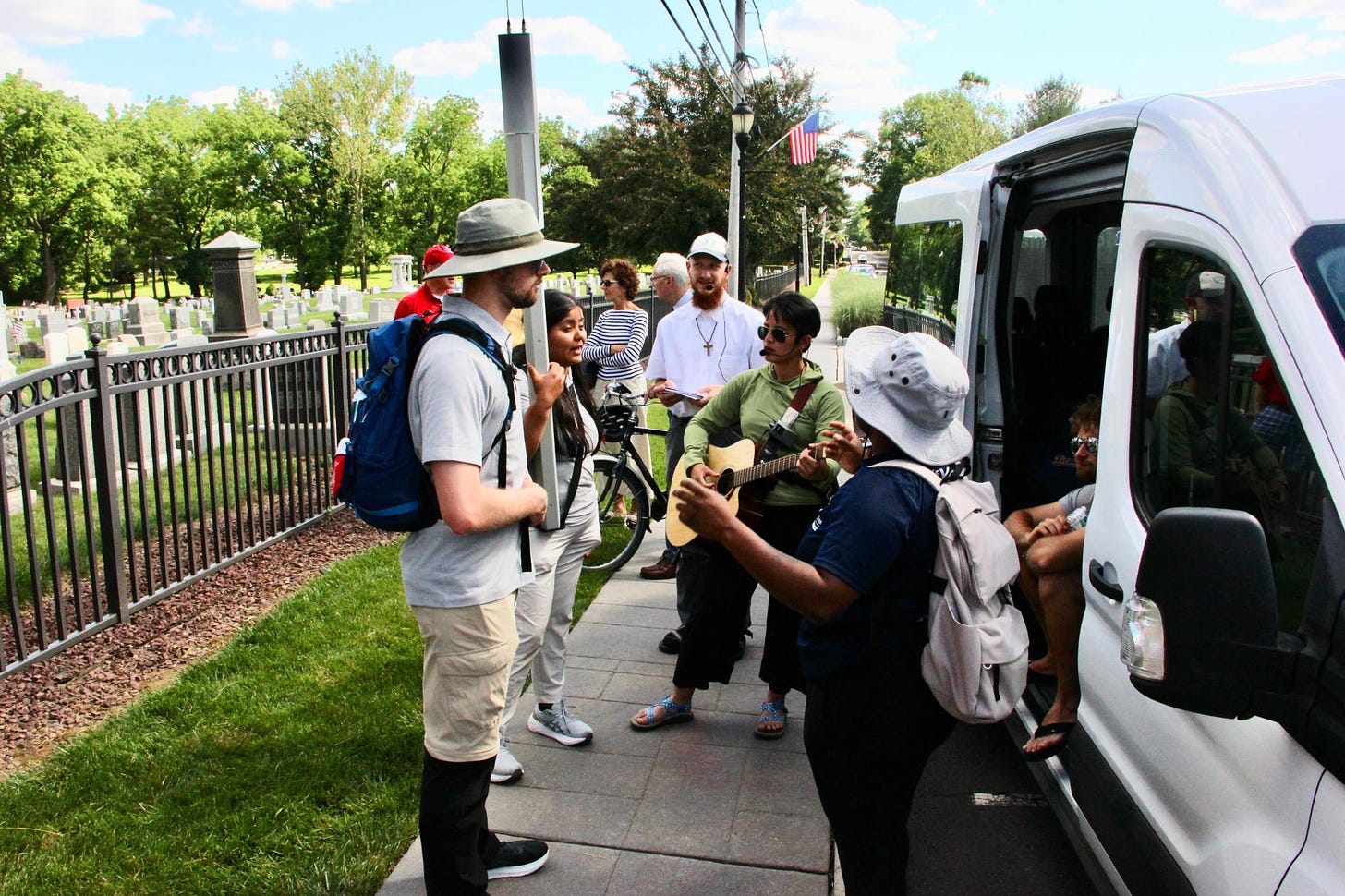
As they tend to do with a lot of things on their trip, pilgrims see a spiritual lesson in the food.
“Receiving the hospitality is a joy,” Dongas said. “At first, it was a struggle. In my own heart, I would say, ‘I don't need that,’ or ‘I can do this myself.’”
“But the Lord kept pushing back, and allowing me to really just receive from people who are so joyful and are so giving, from people who want to share with us.”
Every day, the perpetual pilgrims experience that kind of hospitality in the parishes they visit, and on the streets when they walk.
But hospitality is in full effect when they stay overnight at homes and rectories.
Every night, the perpetual pilgrims stay at a different host home, usually affiliated with the parish where the pilgrimage made its final stop for the day. There, the pilgrims learn about the families they are staying with, sharing their stories from the road and hearing about life in the parish.
“It is not easy for me to constantly change environments; there's a lot of adaptation necessary, and it is not the most comfortable state to exist in this state of constant change,” Frattaroli said.
“But with every place we go, every host we encounter, and every new thing we're introduced to, it's just another facet of God's own life that we're getting the opportunity to share in.”
When hosts go to bed each night, the pilgrims often stay up to talk with each other about what they’re experiencing.
“The girls and I have a lot of girl time in the evening because we're always going in opposite directions during the day,” Higueldo told The Pillar.
“One of my favorite parts of this whole pilgrimage has been sitting with the girls at the end of the day and just talking about how good God has moved or to share the struggles or frustrations or whatever or the joys of the day.”
‘You have to drink so much water’
After a few hours of sleep, the pilgrims wake up, and begin a new day.
On some days, they visit six parishes; other days they visit two.
The pilgrims ensure that they make at least one, undisturbed holy hour. Frequently, they are making two or three holy hours as they stop at parishes for different events.
When they heard about the long durations of prayer, Frattaroli and other pilgrims were concerned about whether that would be realistic for them — but they say now that frequent opportunities for prayer has pushed them to grow spiritually.
“One struggle that's also such a blessing is that I really had to become more persistent in prayer,” Frattaroli said. “Some of our days have many hours of adoration which is a beautiful challenge as we try to be reverent that whole time and to have an appropriate disposition of prayer.”
“I've had to push myself in being able to maintain that and it's been beautiful for my own intimacy with the Lord, to develop that persistence of prayer.”
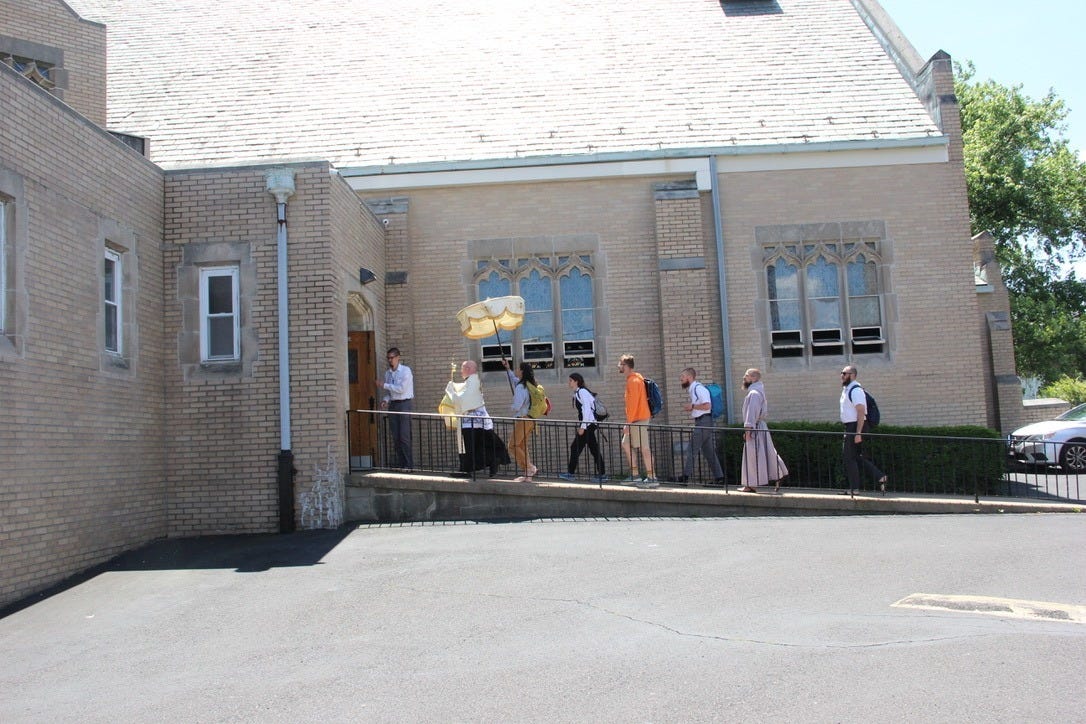
Their prayer is not confined to the Church or adoration chapel, as they follow behind Jesus through the streets during daily Eucharistic processions.
Some days the pilgrims walk 17 miles; other days it is just a short loop around a parish parking lot.
“Walking day in and day out in 85 degrees and 90 degrees in the sun is physically draining; you have to drink so much water,” Carstens told The Pillar.
“Your legs are tired, your feet ache, so physically, that's hard. You have to carry the sound speaker, the cross, the canopy, and so just carrying things can also be difficult.”
“But then you add that you have to be intentional about the smile on your face and always keep Jesus at the center of what you are doing so that your joy will always be present on your face.”
As Carstens noted, the days are long, and the treks go on for miles. The pilgrims spend most of the day on their feet, resulting in a common enemy: blisters.
“One hard thing was when I got my first blister, which wasn't fun,” Dongas said. “It was kind of gross. But then I learned how to pop it, which was pretty exciting, but it was definitely not ideal.”
While they spend a lot of time walking between various parishes, the team also utilizes specially outfitted Ford Transit vans to travel between different churches.
Those vans are not the average large-Catholic-family-mobiles; the Knights of Columbus specifically designed them for the pilgrimage.
The entire front row of seats was removed, and a simple wooden altar took its place. The monstrance can be fixed to the altar with four wooden arms, and below the altar is a tabernacle where the blessed sacrament can be reposed.
As the pilgrims drive between different parishes and towns, the Blessed Sacrament is often exposed, giving the pilgrims a chance to pray without the distractions of coordinating logistics.
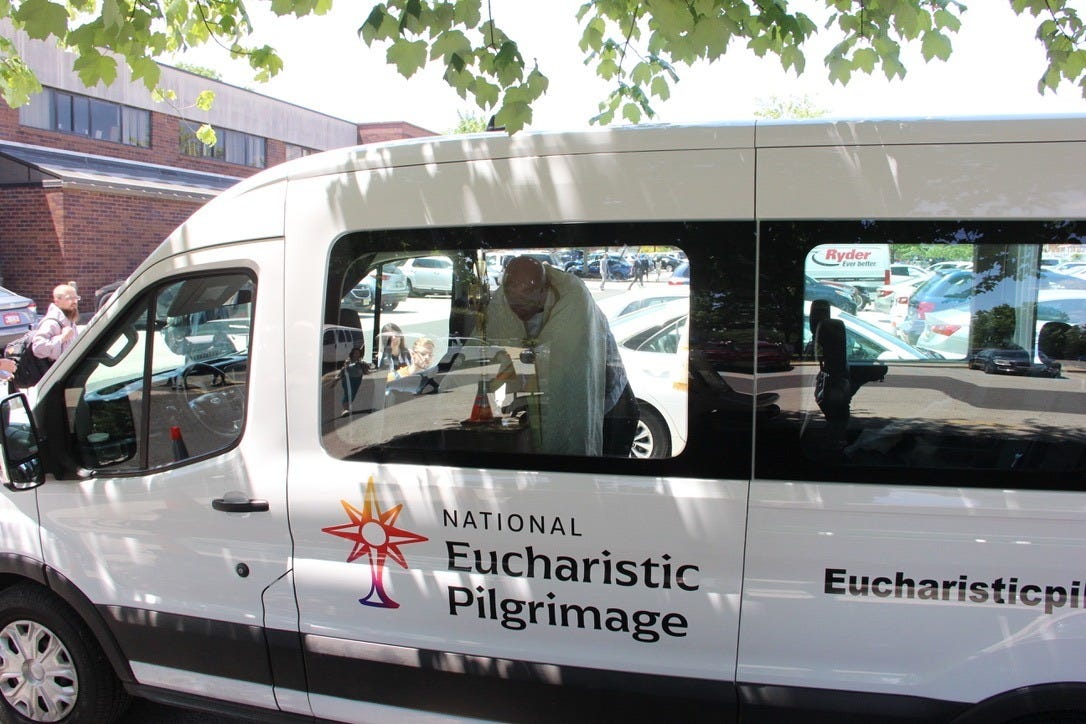
“We're doing a lot of Holy Hours at a lot of events, but often we do not have time to pray during those Holy Hours,” Higueldo said. “We want to be part of the Holy Hour, but logistically, we have to get things done, there's a lot of stuff going on.”
“We use our time in the van to pray, but it's hard to concentrate sometimes. That's been a difficult part for me personally, just because, like, I'll see something along the road and be distracted. I don't think the van was meant for adoration. But the Lord meets us there, and he's just so gracious with us.”
Even if prayer can become distracted, the van rides are beautiful moments, pilgrims say.
But driving through big cities and long stretches of the road with the Blessed Sacrament in the car adds additional pressure for whichever pilgrim is driving.
“When driving the van, there is a lot of pressure,” Carstens, who frequently drives, said. “I now can relate to people who drive the Popemobile a little bit, but I have a way cooler job because I am driving Jesus, and he is there as consolation but also as support.”
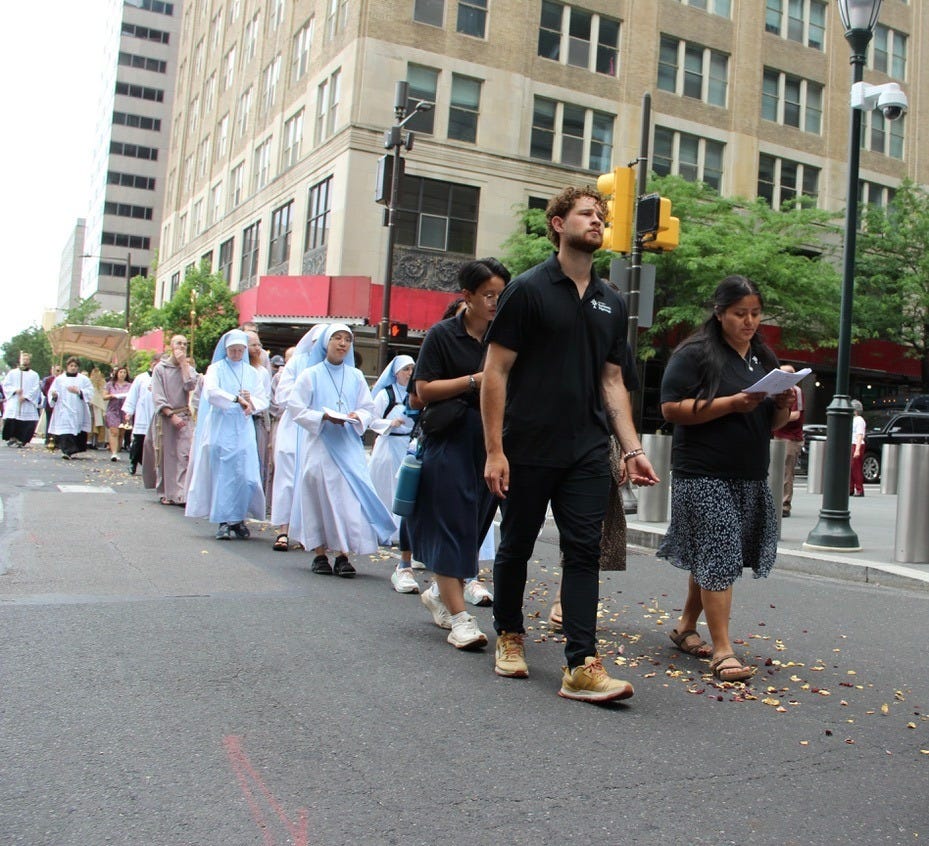
Uno with the team
Before they began their 65-day pilgrimage, the six perpetual pilgrims had met each other in person only once, during a formation retreat held in February. Other than that brief encounter, they were complete strangers.
But most say that now, they’ve made lifelong friends.
Those friendships began with vulnerability.
“You're living out of a van with these people you barely know,” Higueldo said. “You learn that you just have to be vulnerable. This whole pilgrimage takes 65 days, and it requires you to be vulnerable and just be open to your teammates, not just shy away from sharing your heart because if you do not, you're completely closed off.”
“One of the great joys that I was not expecting was the community that we would form as perpetual pilgrims,” Dongas said. “I thought maybe a few of us would become really good friends, but just getting to meet them all and hear their hearts has been such a grace.”
Often, though, it is hard to find time to talk, as the pilgrims are usually praying or talking with people who’ve come to join them. During the moments they do have off, though, the perpetual pilgrims try to spend intentional time with one another.
“We try and steal every one of the moments that we can have to just spend time together,” Bernas said. “When we have the chance to go get coffee or just sit around, we just kind of steal those moments and embrace them because we want to just spend time together.”
“The other pilgrims who are doing this are amazing,” Frattaroli said. “They push me to be better in the way that they use their heart and their skills every single day., by the way they serve the Lord with great faithfulness.
“It's been a joy to witness other young adults pursue God so fearlessly.”
Just as the pilgrims' backgrounds are diverse, so too is their worship style. Some prefer more charismatic workshop, while others opt for a more traditional style.
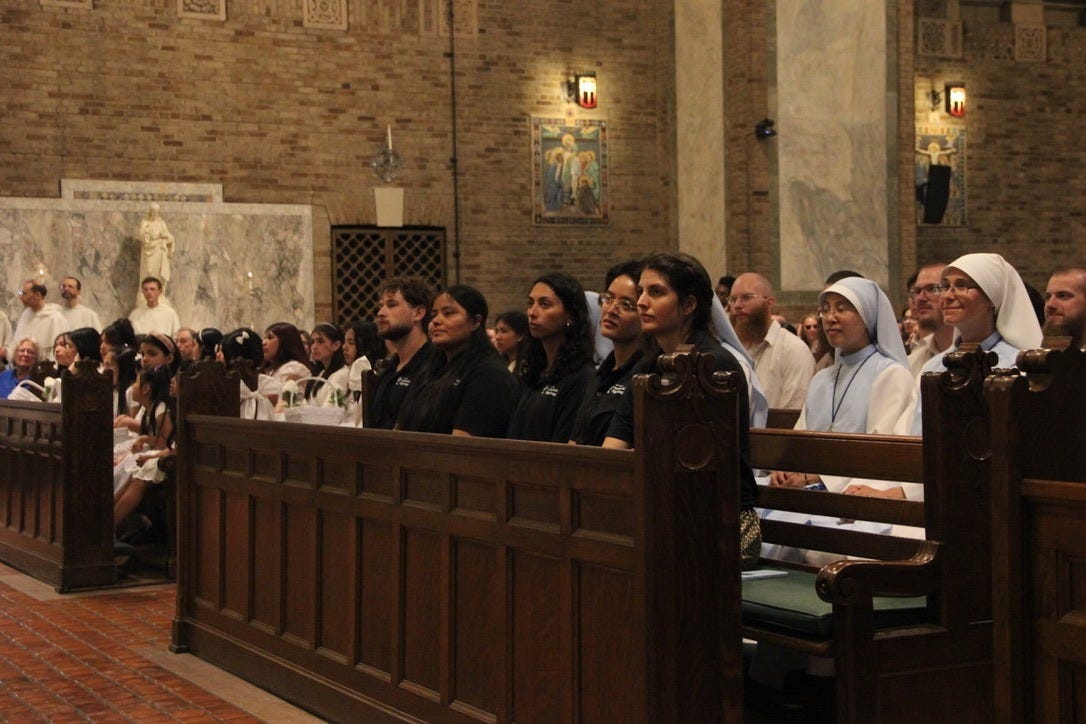
For the seminarian, Bernas, and the CFRs who journey with the pilgrims, the liturgy of the hours is central to prayer life.
“Learning about the different ways people prefer to pray, like praise and worship and meditations, and seeing the prayer routines people have has taught me a lot," Higueldo said. “I'm learning a lot from my fellow pilgrims, such as learning more about the liturgy of the hours which has been a great thing.”
While they have a serious job—walking with Jesus — the pilgrims ensure that they have plenty of time for fun and games.
When time has permitted it, they’ve made time for cards, or quick beach trips.
“One highlight for me has been playing Uno with the team,” Bernas said. “On our first night together, we sustained like an hour and a half-long round of Uno and then we played again on the beach, which was so much fun.”
“All the little moments of joy that I get to share with all of my teammates make this pilgrimage so much fun.”
There are also serious moments.
“There was a moment where we were just in the car chatting, and it fell silent. Someone then asked a silly question about what you were like in high school. And it reminded me of disciples getting bored and thinking, ‘What should we talk about?’ And then someone asked: ‘Who's the greatest among us,’” Garza said.
“I would say that the greatest grace of this pilgrimage has been being able to understand the scriptures in a whole new way through the experiences we have together.”
‘The novelty, and the amazing thing’
The pilgrims say the graces connected to their trip often appear in unexpected ways.
“It's in the hidden places, the places where you wouldn’t expect to find Jesus in, where He most often shows Himself” Carstens said. “That is the best part, when you find Him and you did not expect to.”
Carstens told the story of walking at the back of a Eucharistic procession with a man named Frank.
“Frank is 89 years old; he used a cane, and we had a three-mile procession in 90 degree heat. And Frank, even though he's in the back line, he continued to walk as far as he could,” Carstens said.
“It was strange because he should not have had the strength to do most of the procession, but … I walked with Frank the entire way.”
“Frank had so much joy that he just got to follow Christ; it was the first time my eyes were really opened up to the grandeur, the novelty, and the amazing thing that we're doing here on the National Eucharistic Pilgrimage.”
Pilgrims say they’ve experienced a lot of grandeur, and a lot of novelty.
“There have been some amazing moments, like bringing Jesus on the boat to the Statue of Liberty,” Higueldo said.
“But besides that, it's the people that we encounter that have been so moving. There's so many people with so much faith just joining along, knowing that the Lord is pouring himself out during this pilgrimage and they want to encounter him in that.”
For Bernas, used to the structure of seminary life, said adjusting to the unpredictability of a pilgrimage was at first difficult.
But soon, he began to see God at work.
“I have really learned to trust in God and that I don't need to know everything at every moment, which means I have also learned how to trust in my teammates,” Bernas said. “I have had to adapt and learn that the people who need to know the schedule know the schedule, and I just show up and help out when I need to.”
“It has taught me to worry about what I've got to worry about and let other people worry about what they've got to worry about. That's been a big teaching moment for me on this trip so far.”
“I did not expect how peaceful it would be in the midst of all the chaos of trying to organize things and make sure that everything's happening and flowing as it should,” Bernas said. “But a lot of peace can be had by just stealing five minutes and just going to pray in silence.”
Frattaroli told The Pillar that kind of peace is a fruit of God at work. Its best fruit, she said, is conversion.
“What's happening is very personal,” Frattaroli said. “It's personal for us, the pilgrims who are walking it; it's personal for those who planned it; for the bishops in the cities we've gone through, this is very dearly personal to their hearts. What we're asking for in a Eucharistic revival is that we're ultimately asking for that revival to be very personal to individuals. In the United States.”
“What we're looking for is not anything but systematic; instead, it is something deeply individual.”

